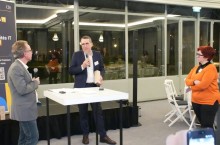CIO en VO : Le réseau social d'entreprise facteur de succès
Paul Gillin, auteur de 'The New Influencers', revient sur les expériences de la holding Sabre, d'IBM, Pfizer, des hôtels Hilton ou encore de l'assureur Wachovia pour justifier de l'intérêt pour l'entreprise de disposer d'un réseau social.
PublicitéWeb 2.0 really is going behind the corporate firewall, where companies like Sabre Holdings, Hilton Hotels and IBM are building social networks for their employees and customers. The key to their early successes is to focus on how people want to connect, not the IT tools they will use. When the folks at travel company Sabre Holdings saw how people were using their new Bambora travel advisor, it got them to thinking. Bambora is a simple social network for travelers, one of many products Sabre Holdings has developed for the travel industry. It uses a basic question-and-answer interface, so travelers can submit questions like "What's a good hotel on Mykonos?" to the community of members for answers. Answers are captured to a searchable database for posterity. Sabre built Bambora to be a public-facing product, but managers immediately saw its utility within the company. As Sabre has evolved and diversified over the last few years, its employee base has become fragmented across the world. This has challenged Sabre to manage projects and sustain teamwork among its 9,000 employees. It had become difficult even to keep track of which skills existed within the far-flung organization. From Bambora, SabreTown was born. The internal social network is now widely used by Sabre Holdings employees to find expertise that would otherwise have been buried within the organization. Questions entered into SabreTown are processed by a relevance engine and built into employees' personal profiles. Sabre is effectively creating a massive knowledge base that employees willingly populate with their own information. "This is an online hallway" says Al Comeaux, senior vice president of corporate communications at the travel firm. "It's an opportunity to build a culture." It's also a chance to capture and preserve corporate knowledge. That's becoming an increasingly pressing concern in U.S. companies. The ratio of U.S. citizens under the age of 65 to those over 65 is expected to decline from more than 7:1 today to about 4:1 by 2030. Businesses are scrambling to preserve expertise that can be passed along to the next generation of employees. That has IT and human resource managers looking to the Internet for solutions. And like so many recent Internet trends, the phenomenon called Web 2.0 or social media is finding acceptance in consumer markets first before working its way inside the corporate firewall. Nearly everyone is familiar with the stunning success of social networks like Facebook and LinkedIn, which together count nearly 100 million members. Now big businesses are adapting public services to their own needs. Forrester Research estimates that the market for internal social media applications will reach $4.6 billion by 2013. Enterprises are finding a variety of innovative uses for social media: - IBM has an internal podcast library of more than 12.000 files with over 100.000 subscribers. Podcasts have cut costs and improved the quality of internal communications among IBM's 400.000-person workforce, 40% of whom do not work in an office. - Pharmaceutical giant Pfizer Corp. uses an internal wiki called Pfizerpedia to capture knowledge about its products and processes. It's now building out a social network similar to Facebook inside the firewall, as Computerworld has reported. - Wachovia is using an internal social network to bind together its far-flung employee base and to attract the next generation of workers, who increasingly expect to have such services at their fingertips. Some companies are taking a hybrid approach by building private communities of customers for use in market research and even product development. - Hilton Hotels Corp. has engaged with several hundred frequent travelers in just such a community for about two years. Market researchers bounce ideas off the group, solicit suggestions for new services and even tap the members for competitive insight, according to Christine Hight, Hilton Family's director of customer research. The initiative has become a core part of the company's market research efforts. Enterprise pioneers say the secret to success in social media is to discard assumptions about how tools should be used and to let users experiment. Sabre Holdings executives knew that if the company restricted the use of SabreTown strictly to business applications, adoption would be slow. The company instead chose to allow employees to adopt the tool for personal use as well as for business advice, leading to rapid adoption, Comeaux says. The first application of podcast within IBM was a battle of the bands, according to George Faulkner, who heads up the company's internal podcasting effort. Early experiments piqued employee interest and staffers quickly figured out how to apply the technology to their business needs. "This wasn't about knowledge-sharing," Faulkner says. "It was about community-building."
Article rédigé par
CIO Etats-Unis










Commentaire
INFORMATION
Vous devez être connecté à votre compte CIO pour poster un commentaire.
Cliquez ici pour vous connecter
Pas encore inscrit ? s'inscrire